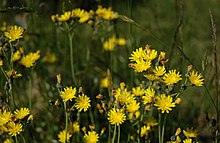Hawkweed
| Hieracium | |
|---|---|
 |
|
| Hieracium caespitosum | |
| Scientific classification | |
| Kingdom: | Plantae |
| (unranked): | Angiosperms |
| (unranked): | Eudicots |
| (unranked): | Asterids |
| Order: | Asterales |
| Family: | Asteraceae |
| Tribe: | Cichorieae |
| Subtribe: | Hieraciinae |
| Genus: |
Hieracium L. |
| Synonyms | |
|
|
Hieracium /haɪ.ərˈæsiəm/, known by the common name hawkweed and classically as hierakion (from ancient Greek ιεράξ, hierax 'hawk'), is a genus of the sunflower (Helianthus) family Asteraceae (or Compositae), and closely related to dandelion (Taraxacum), chicory (Cichorium), prickly lettuce (Lactuca) and sow thistle (Sonchus), which are part of the tribe Cichorieae. Hawkweeds, with their 10,000+ recorded species and subspecies, do their part to make Asteraceae the second largest family of flowers. Some botanists group all these species or subspecies into approximately 800 accepted species, while others prefer to accept several thousand species. Since most hawkweeds reproduce exclusively asexually by means of seeds that are genetically identical to their mother plant (apomixis or agamospermy), clones or populations that consist of genetically identical plants are formed and some botanists (especially in UK, Scandinavia and Russia) prefer to accept these clones as good species (arguing that it is impossible to know how these clones are interrelated) whereas others (mainly in Central Europe and USA) try to group them into a few hundred more broadly defined species. What is here treated as the single genus Hieracium is now treated by most European experts as two different genera, Hieracium and Pilosella, with species such as Hieracium pilosella, Hieracium floribundum and Hieracium aurantiacum referred to the latter genus. Many members of the genus Pilosella reproduce both by stolons (runners like those of strawberries) and by seeds, whereas true Hieracium species reproduce only by seeds. In Pilosella, many individual plants are capable of forming both normal sexual and asexual (apomictic) seeds, whereas individual plants of Hieracium only produce one kind of seeds. Another difference is that all species of Pilosella have leaves with smooth (entire) margins whereas most species of Hieracium have distinctly dentate to deeply cut or divided leaves.
...
Wikipedia
